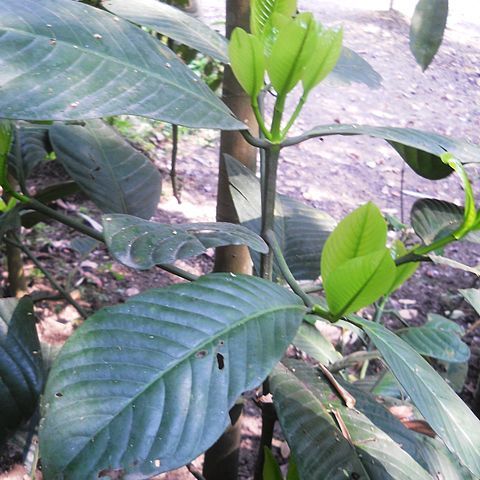Trees ca. 20 m tall. Bark thick, corky; branchlets obtusely 4-angled or subterete, striate, lenticellate, glabrous. Petiole 2-2.5 cm; leaf blade oblong, obovate, or oblong-lanceolate, (12-)15-25(-28) × 7-12 cm, papery, midvein robust, raised abaxially, somewhat impressed adaxially; secondary veins regular, oblique, 9-14 pairs, near margin arching and joining together; tertiary veins nearly parallel, almost inconspicuous, base cuneate, margin conspicuously narrowly involute, apex usually rounded, rarely obtusely acuminate. Plant dioecious, flowers 4-merous. Male flowers 8-12 in an erect 8-15 cm paniculiform cyme; peduncle 3-6 cm; pedicels robust, 3-7 cm; sepals broadly ovate or suborbicular, thick, fleshy, margin membranous; petals yellow, oblong-lanceolate, 7-8 mm; stamen fascicles connate in capitate ring ca. 3 mm high, anthers sessile, or a few near pistillode with short filaments, anthers 2-celled, cells longitudinally dehiscent; pistillode columnar-cuneate, slightly angular; stigma peltate, inconspicuously tuberculate. Female flowers usually in pairs or solitary at apex of branchlet; pedicels robust, slightly tetragonous, with 2 suborbicular bracts at base; staminodes basally united, surrounding ovary, 80-100, upper parts free; ovary subglobose, 8-10-loculed; stigma radiate, 8-10-lobed, papillate. Fruit yellow, large, oblate, concave on both ends when mature, 10-18 × 11-20 cm, smooth; fruiting pedicel 5-6 cm. Seeds 8-10, reniform. Fl. Aug-Dec, fr. Dec-Jan.
More
A large tree. It grows about 20 m high. It keeps its leaves throughout the year. The trunk is fluted. The branches are short and spreading. The small branches are 4 angled. The leaves are sword shaped. The leaves are 16-26 cm long by 7-10 cm wide. The flowers are green. The male flowers are in clusters of 8-12 flowers and the female flowers occur singly or in groups of 3. The fruit are 8-10 cm long and yellow-orange. There are 8-10 kidney shaped seeds.

